Wheels, Discs, Concentric Circles
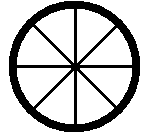 Other Pictures, Problems and Procedures
Other Pictures, Problems and Procedures
Drawing wheels and discs is just a matter of drawing concentric circles, but how can you draw concentric circles in Paint, which has no "draw from centre" facility?
It's a lot easier than you thought.
If you would like to work in Paint while you follow these instructions, do remember that you can resize your browserA Browser is the program you use to visit sites on the Internet. Internet Explorer (IE) may be the browser that you use, but there are many others, such as Firefox, Opera, Google Chrome, K-Meleon and Blackbird.
You can have as many browsers as you like, and run more than one at the same time. window. If the window is maximised—taking up the whole screen—you'll first need to click the restore button (the middle one of these) ![]() , then just hover your cursor over a side edge of the browser window until a double-headed arrow appears, press your left mouse button and drag left or right until the window is a suitable size.
, then just hover your cursor over a side edge of the browser window until a double-headed arrow appears, press your left mouse button and drag left or right until the window is a suitable size.
You can then grab the browser window by the title bar and drag it to the position that you want it in. You can do this with almost any window on your computer.
Making concentric circles
Open workspace.bmp or workspace.gif. If you haven't made that yet, please read Your workspace file. The infomation there is important, and will make all the difference to easy working. You only need to set up the workspace once and you're all set.
Draw two differently sized squares
Have your window wide enough to let you see the right-hand end of the status bar. For me, that's 500 pixels.

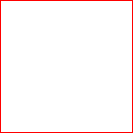

Click on the Line tool and set the thickness to one pixel—the top option.
 Click on the Rectangle tool and choose the top option, outline with no fill.
Click on the Rectangle tool and choose the top option, outline with no fill.
![]() Have red as your foreground color.
Have red as your foreground color.
Hold the Shift key while you draw a square.
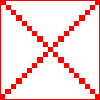
 The size of the square doesn't matter, except that the sides should be an odd number. Squares of odd numbers have a single pixel where diagonals cross at the centre. Squares of even numbers have a block of four pixels in that position, which would cause problems in this exercise. top
The size of the square doesn't matter, except that the sides should be an odd number. Squares of odd numbers have a single pixel where diagonals cross at the centre. Squares of even numbers have a block of four pixels in that position, which would cause problems in this exercise. top
.
My squares are 123x123 and 133x133. However, there's a small problem. Easily overcome once you're aware of it, but it had me tearing my hair for a day or two.
The number on the status bar is one more than the square you're drawing!
This has been fixed in Paint for Windows 7.
![]() So, if you want a square of 123x123, watch the status bar for 124x124. moreIf you don't believe me—and why should you, because it sounds ridiculous—draw a square and note what the status bar says, then click on the rectangular selection tool and very carefully select the square, starting exactly on its upper left corner and finishing exactly on the lower right corner. What does the status bar say? Convinced?
So, if you want a square of 123x123, watch the status bar for 124x124. moreIf you don't believe me—and why should you, because it sounds ridiculous—draw a square and note what the status bar says, then click on the rectangular selection tool and very carefully select the square, starting exactly on its upper left corner and finishing exactly on the lower right corner. What does the status bar say? Convinced?
Size difference affects thickness
The difference between the sizes of the two squares will determine the thickness of the wheel. If you want a disc with a hole in the middle, have the small square much smaller than the other one. If you want something skinny, like a bicycle wheel, make the small square nearly as big as the other.
The current sizes will result in something vaguely like a bicycle wheel. For a fatter wheel, you'd use a smaller inner square, as shown here.
.
Draw diagonals

 Zoom in to 2x.
Zoom in to 2x.
Click the Line tool.
Position your cursor exactly on the top left-hand corner of the square
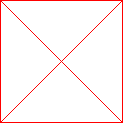 Hold the Shift key and draw a line down to the bottom right-hand corner.
Hold the Shift key and draw a line down to the bottom right-hand corner.
Position your cursor exactly on the top right-hand corner of the square
Hold the Shift key and draw a line down to the bottom left-hand corner.
Do the same thing with the other square. top
Make safe copies
 Still zoomed in to 2x—or a closer view if you prefer—click the Rectangular Selection tool.
Still zoomed in to 2x—or a closer view if you prefer—click the Rectangular Selection tool.
Click on the transparency option—the lower one.
Draw a selection marquee around the smaller square.
Press the Ctrl key as you begin to drag, and put a copy of the smaller square over to the side somewhere.
Do the same thing with the larger square.
Put the small square onto the big one
 Now go back to your original small square, select it again, and drag it right on top of the larger one. Get it into such a position that you can only see one set of diagonals.
Now go back to your original small square, select it again, and drag it right on top of the larger one. Get it into such a position that you can only see one set of diagonals.
Until you click away, you can wiggle the small square around until it's in exacly the right place.
When you are satisfied, click away.
 Should your cursor jump at the last second, so that you can see both lots of diagonals after you've clicked away, either press Ctrl+z or go to the Edit menu and choose Undo. Then try again.
Should your cursor jump at the last second, so that you can see both lots of diagonals after you've clicked away, either press Ctrl+z or go to the Edit menu and choose Undo. Then try again.
The reason I suggested that you make safe copies of the squares is that sometimes when you click Undo the piece you were dragging disappears altogether instead of just going back to where it was. top
Draw circles
Choose black from the color palette.
 Click on the Ellipse tool and choose the top option, Outline with No Fill.
Click on the Ellipse tool and choose the top option, Outline with No Fill.
If you are drawing a disc rather than a wheel, you may wish to choose a 3 or 5 pixel line thickness for your circle.
Avoid 2 and 4 pixel line thicknesses; I found the resultant circles were uneven and blocky.
.

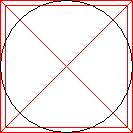 Position your cursor on the top left hand corner of the outer square.
Position your cursor on the top left hand corner of the outer square.
Drag a circle down to the bottom right corner of the outer square.Your circle should meet the square in the same way on all four sides. The very widest part of the circle will be right on the red lines.
 To make this happen, you need to finish your circle one pixel below and one pixel to the right of the bottom corner.
To make this happen, you need to finish your circle one pixel below and one pixel to the right of the bottom corner.
.
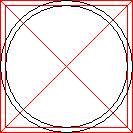 Now draw a second black circle, starting from the top left-hand corner of the inner square.
Now draw a second black circle, starting from the top left-hand corner of the inner square.
Again, make sure that it touches the square in the same way on each of the four sides. top
If you are making a disc rather than a wheel, continue here.
Draw spokes
If your drawing is to be of a disc with a hole in the middle, like a CD or DVD, you do not need to draw spokes. Go straight to removing your construction lines
If your drawing is to be of a wheel, then you do need them.
Zoom in to the very centre of the drawing.
Still with black as your foreground color,

Holding the Shift key to force a straight line, draw a line from the centre straight down until it meets or crosses the inner black circle. 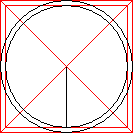
.
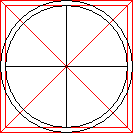 Do the same thing from the other three sides of the central pixel.
Do the same thing from the other three sides of the central pixel.
You should now have a black cross in the middle of the inner circle. top
Trace the diagonals
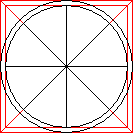 From the inner circle, trace each of the red diagonals with black, stopping at the other side of the inner black circle. You can hold the Shift key to make this easier.
From the inner circle, trace each of the red diagonals with black, stopping at the other side of the inner black circle. You can hold the Shift key to make this easier.
If you're planning to thicken the spokes, use a 3 pixel line thickness to do this. If you prefer to keep the thin lines, stay with that option.
You now have eight black spokes radiating from the centre to the inner circle. top
Remove the construction lines
You can zoom out to 2x now.

Click on dark green, click on the Rectangle tool and select the top option, Outline with No Fill.
 Put your cursor a few pixels above and to the left of the top left corner of the red square.
Put your cursor a few pixels above and to the left of the top left corner of the red square.
Draw a green rectangle around your picture. It doesn't need to be evenly positioned; it's just a barrier to protect the rest of your page from the flooding you're about to do. It's pretty startling to have your whole window turn bright red—and if you have other drawings on the page, they could be damaged.
![]()
![]() Click on the Flood Fill tool and click on red. Make sure you have white as your background color so you'll get white when you click with your right button.
Click on the Flood Fill tool and click on red. Make sure you have white as your background color so you'll get white when you click with your right button.
.
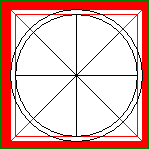
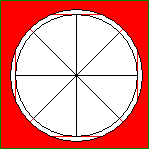 Put the Flood Fill cursor between the big red square and the green protective square. Click with your left button, then with your right button. Do this several times. Each time you click with your left button, the area colored red will be greater than it was before. Your last right click will leave a clean white area around the wheel.
Put the Flood Fill cursor between the big red square and the green protective square. Click with your left button, then with your right button. Do this several times. Each time you click with your left button, the area colored red will be greater than it was before. Your last right click will leave a clean white area around the wheel.
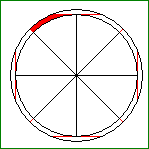

Then move your Flood Fill cursor into the space between the two black circles and repeat the left click-right click as many times as necessary until you have a plain black and white outline picture of a wheel.
There's no need to move your cursor from place to place around the wheel; just keep clicking red-white, red-white and the affected area will grow until all the red has gone.
.
 Click once with your right button on the protective green border to remove it.
Click once with your right button on the protective green border to remove it.
 Change your foreground color to black and click between the two circles to color the wheel. top
Change your foreground color to black and click between the two circles to color the wheel. top
Thicken the spokes if you want to
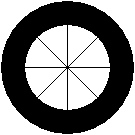
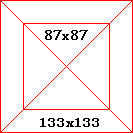 If the proportions of your wheel are similar to those in the pictures above, the fine line spokes should look well balanced. If, though, you made a fatter wheel, you'll probably want to thicken the spokes.
If the proportions of your wheel are similar to those in the pictures above, the fine line spokes should look well balanced. If, though, you made a fatter wheel, you'll probably want to thicken the spokes.
![]() Still zoomed in, click the Line tool and change your option to the middle one—a three pixel line, or the last one, a five pixel line.
Still zoomed in, click the Line tool and change your option to the middle one—a three pixel line, or the last one, a five pixel line.
Avoid two and four, because it's much harder to get them looking right.
Put your cusor at the top of the vertical line. Make sure it's right on the thin black line. This will make the extra thickness be even on both sides of the original line.
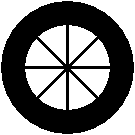 Hold the Shift key while you draw down to the bottom of that vertical line.
Hold the Shift key while you draw down to the bottom of that vertical line.
Do the same thing with the horizontal line and with the diagonals.
Save a copy
Click on the Rectangular Selection tool.
Draw a marquee around your finished wheel.
Go to the Edit menu and choose Copy To.
Save the cutout as wheel.bmp or a more specific name—bicycle_wheel.bmp or car_wheel.bmp perhaps (bicycle_wheel.gif if you're using Vista). top
Clean your workspace
After you've copied and saved the picture, have a quick look around your workspace to make sure there's nothing else you want to copy and save. If there is something, copy and save it now, using the same Copy To procedure.
Then
Make sure that you have white as your background color.
Go to the Edit menu and click Select All.
Hit the Delete key.
Go to the File menu and click Save.
Close Paint and go for a walk in the sunshine (or do something else you find restful).
Add extra spokes
If you feel you'd like more than eight spokes, there are directions for drawing twenty-four spokes, and directions for attaching extra spokes to a wheel.
Use in new work
This picture is now saved and ready to be added to a picture of any kind or format. You may wish to paste it into an otherwise finished picture, or you may simply want to paste it into a cleaned save of your workspace so that you can add details, change the color or use it to build a more complicated drawing.
Whenever you want to use the wheel you've just saved, with Paint open, go to the Edit menu and choose Paste From.
Navigate to your saved picture, click its name and click Open.
The picture will appear in the top left-hand corner of your Paint window. Don't click anywhere else on the page until you've dragged the wheel to where you want it. Clicking outside the selection marquee—or clicking any other tool or menu item—will paste the cutout.
Ctrl drag as many copies as you need.
Change the pasted picture in any way you want to. Your saved copy will not be affected.
A disc without spokes
If you are drawing a disc, you won't want spokes, of course so you'll do things slightly differently.

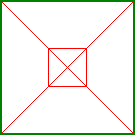 Begin by following the directions from the drawing of the two squares, but make the sizes of the two squares very different, as in this example.
Begin by following the directions from the drawing of the two squares, but make the sizes of the two squares very different, as in this example.
When you've drawn your two squares and centred the smaller one on the larger one, decide whether you want a thicker outline for your disc. Then continue the directions from Draw circles.
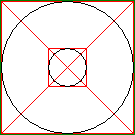
 When the outline of the disc is as you want it,
remove the construction lines and color or decorate the disc as you like.
When the outline of the disc is as you want it,
remove the construction lines and color or decorate the disc as you like.

.
Other Pictures, Problems and Procedures
Questions or comments? I'd love to hear from you, especially if you have helpful suggestions regarding any one of this set of pages. They were begun in response to some reader questions and I've arrived at solutions through trial and error. As I went over the exercises and tried to follow my own instructions, I several times saw a quicker or easier way to do something and it's likely that readers may still see some better solutions.
My email address is here.
Return to top
Drop-Down Menu from Brothercake
Everything below this is a javascript menu. If you are using a reader,
please use the links here.